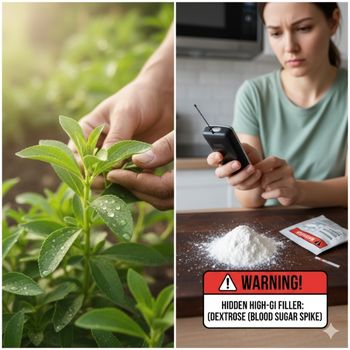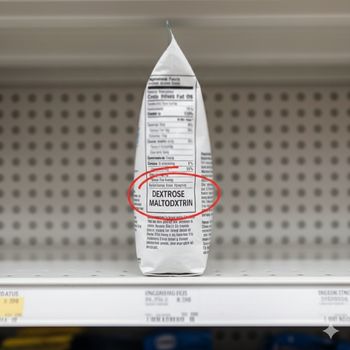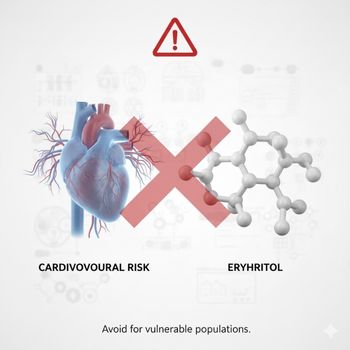Does Stevia Raise Blood Sugar? The Definitive Guide to
Insulin, Fillers, and Your Safety ❤️

If you are managing your blood glucose, strictly counting carbs for keto, or simply trying to make the healthiest choices for your family, you’ve likely been told that stevia is the perfect, natural sugar swap.
So why do you feel confused? Why are you searching right now for the answer to the urgent question: does stevia raise blood sugar? 🤯
The anxiety you feel is completely valid. It’s driven by confusing marketing, conflicting personal experiences, and products that hide high-glycemic traps inside "natural" packaging.
As a PhD student specializing in agriculture and health—and honestly, as a friend who grew up on a farm—my goal is to share verifiable facts. We are going to cut through the noise and arm you with the detective skills needed to protect your metabolic health.
The truth is simple: pure stevia is one of the most powerful plants available, but the cheap fillers in most commercial products are the true culprits sabotaging your efforts.
Your Urgent Metabolic Questions Answered: Summary in
Bullets
I know you need to feel confident now. This deep dive is designed to give you clinical-grade answers and an actionable protection plan.
- The Zero-GI Fact: Pure, high-purity Steviol Glycosides (Reb A/M) have a Glycemic Index (GI) of virtually zero and do not raise blood sugar or insulin. This is why organizations like the American Diabetes Association (ADA) approve its use for diabetics.
- The Hidden Trap: The consumer confusion—the spike you might feel—is caused entirely by cheap bulking agents in powdered packets, namely Dextrose (GI 100) and Maltodextrin (GI 95-105). These are pure sugar/starch, and they will absolutely raise your blood sugar.
- The Cardiovascular Warning: Beyond blood sugar, you must avoid the sugar alcohol Erythritol if possible. While it’s zero-calorie, recent critical research suggests high blood levels are associated with increased risk of Major Adverse Cardiovascular Events (MACE), like heart attack and stroke, in vulnerable populations.
- Your Protection Plan: The only way to guarantee metabolic safety is to stop trusting marketing claims and become a label detective. You must exclusively use pure liquid drops or extracts that contain zero Dextrose, Maltodextrin, or Erythritol.
I. The Pure Science: Why Stevia Doesn't Raise Blood Sugar
To build absolute trust, we must start at the molecular level. When we talk about "stevia" in a clinical setting, we are talking about Steviol Glycosides (SGs)—the highly purified extracts like Rebaudioside A (Reb A) or Rebaudioside M (Reb M).
The Glycemic Index (GI) Guarantee
The Glycemic Index (GI) is your best friend when managing blood sugar. It tells you how quickly a food’s carbohydrates will enter your bloodstream as glucose.
Pure SGs are not carbohydrates. They are non-nutritive sweeteners (NNS) because they contain virtually zero calories and zero net carbs. This is the core property that makes them metabolically neutral.
Result: Pure Stevia extract has a GI of near 0.
Analogy: Think of SGs like a perfectly tailored key that fits the sweetness lock on your tongue but has no corresponding lock in your digestive tract for processing or energy storage. The SGs pass through your system without providing the glucose needed to trigger a spike.
This fundamental truth is the anchor point for all safety claims. If your blood sugar spikes after consumption, I can tell you right now, as your trusted friend: The pure stevia isn't the problem.
The Official Consensus: Why is Stevia Good for Diabetics?
For those asking is stevia good for diabetics, the highest authorities in health have confirmed its utility.
The ADA (American Diabetes Association) includes stevia sweeteners (like Truvia) among the approved sugar substitutes that do not raise blood glucose levels. This endorsement isn't just a casual nod; it's a recognition that, when used as a replacement for caloric sugars, stevia can be a powerful tool for:
- Reducing overall carbohydrate load.
- Facilitating weight control by cutting empty calories.
- Maintaining consistent blood glucose levels is crucial for preventing complications.
The Long Game: Stevia and HbA1c Stability
You aren't just worried about a single meal spike; you care about your long-term health, measured by your Glycated Hemoglobin (HbA1c). This is your average blood sugar level over two to three months.
My research as a PhD Scholar suggests that long-term studies on steviol glycosides are very reassuring. A meta-analysis of long-term randomized controlled trials (RCTs) found that stevia consumption resulted in no significant negative effect on key glycemic control markers, specifically blood glucose levels and HbA1c.
This proves that when you commit to pure stevia, you are not secretly compromising your multi-month effort to manage your diabetes. You are supporting it.
II. Beyond Neutrality: Stevia, Insulin, and Incretin
Hormones 💪
Many metabolically savvy individuals, particularly those managing insulin resistance, don't just want zero glucose; they want zero hormonal disruption.
Stevia's Acute Effects on Insulin and GLP-1

The physiological response to sweetness is complex. While pure stevia does not trigger the massive insulin surge of table sugar, some advanced literature suggests NNS, including stevia, may trigger subtle physiological responses associated with carbohydrate metabolism. This can include the release of:
- Insulin: A minor, temporary response that is not comparable to sugar.
- Incretin Hormones (like GLP-1): These hormones are released after eating and actually function to reduce blood glucose by stimulating insulin secretion and slowing gastric emptying.
Simplified Takeaway: This is not a dangerous spike. It's the body recognizing the sweet taste and engaging a very minor glucose reduction system. For most people, this minimal activity is safe and preferable to sugar.
Potential Therapeutic Benefits for T2DM
This subtle engagement with the body’s glucose regulatory system is actually where pure stevia shines as a potentially beneficial agent, moving it past mere substitution.
From an academic perspective, research suggests steviol glycosides may offer certain anti-diabetic capabilities, including:
- Enhancing Insulin Secretion
- Improving Insulin Resistance
This is fascinating work because it suggests SGs don't just replace sugar benignly; they may actively help improve the metabolic environment. From what I've learned in my research and seen on the farm (where we try to use foods as medicine), finding a compound that tastes sweet and offers therapeutic potential is incredibly valuable for patients attempting to adjust to a non-sugar diet.
III. The Label Detective: Exposing the High-Glycemic
Saboteurs 🕵️♀️
Now we confront the real reason so many people search: does stevia raise blood sugar. The spike you might experience is not a failure of the stevia leaf; it is a failure of commercial integrity.
Why Do They Need Fillers?
I want to be transparent: Steviol Glycosides are intensely sweet—up to 300 times sweeter than sugar. A pinch is enough to sweeten an entire drink. You can’t measure that small amount with a teaspoon!
To give you a standard "packet" or a "spoon-for-spoon" blend, manufacturers must add volume, or "bulk." This is where the trap lies.
The Dextrose and Maltodextrin Metabolic Bomb
The most prevalent and metabolically problematic additions found in commercial stevia powders are cheap, high-glycemic fillers: Dextrose and Maltodextrin. These ingredients are pure glucose or refined starch, and they commit metabolic fraud:
⚠️ High-Glycemic Stevia Fillers: Know Your Risk ⚠️
| Filler / Additive 🧪 | Source Type 🌽 | Average Glycemic Index (GI) 🔥 | Metabolic Threat (Simplified) 🚨 |
|---|---|---|---|
| Dextrose | Pure Glucose | ≈ 100 | Massive Spike. It's pure sugar. The worst offender for blood sugar control. |
| Maltodextrin | Refined Corn/Starch | 95–105 | Major Spike. Absorbs faster than table sugar. Common in bulk or baking blends. |
Note: Always read the full ingredients list on packaged stevia products.
If you are diabetic or on a keto diet and notice a blood sugar spike after using a stevia product, you have undoubtedly been exposed to Dextrose or Maltodextrin.
The "Stevia in the Raw Ingredients" Deception
Compounding the problem is deceptive labeling. Many commercial powders, even those marketed as "natural," list Dextrose as the first—and thus most abundant—ingredient.
This practice is allowed by an FDA regulatory loophole: a product can claim "zero-calorie" or "dietetically zero" if it contains less than 4 calories per serving. While a tiny packet might meet this calorie threshold, that small amount of high-GI dextrose is more than enough to trigger an unwanted metabolic spike in sensitive individuals.
You simply cannot rely on front-of-package claims like "Stevia in the Raw," "Pure Via," or even the calorie count. Your protection lies in turning the package over and reading the ingredients list for yourself.
IV. The New Safety Frontier: Erythritol and
Cardiovascular Risk 💔
For years, the advice for avoiding dextrose was simple: switch to a stevia blend that uses a sugar alcohol, particularly Erythritol, as a filler.
Why? Because Erythritol, unlike dextrose, has a GI of 0 and generally passes through the body without raising blood sugar.
However, metabolic safety is an evolving science, and our definition of "safe" must expand beyond just immediate blood sugar metrics.
The MACE Warning

A critical scientific report published in 2023 introduced a high-stakes concern for metabolically vulnerable populations. This report found a strong association: people with the highest circulating blood levels of Erythritol demonstrated a greater risk of Major Adverse Cardiovascular Events (MACE), including heart attack, stroke, and blood clots.
Research shows that pilot studies revealed something alarming: ingesting Erythritol can cause plasma levels to rise and remain elevated for more than two days. These elevated levels crossed established thresholds associated with heightened platelet reactivity, increasing the potential for thrombosis (blood clotting) in both lab and human studies.
The Caution for Diabetics and Kidney Health
For our visitors—diabetics, pre-diabetics, and those with existing heart conditions—this is a serious new factor. These groups frequently have pre-existing cardiovascular risk factors.
While more large-scale, long-term research is ongoing, the initial findings necessitate a strong recommendation: If you are at high risk for heart events or have impaired kidney function, it is prudent to seek out pure stevia products that do not contain Erythritol.
This dramatically changes the shopping strategy. The goal is no longer just "zero-GI." The goal is "zero-GI, zero-Dextrose, and zero-Erythritol."
V. Stevia, Ketosis, and Strict Fasting (IF) 🏃♀️
The metabolic precision required for specialized diets demands clear guidance on stevia.
Stevia and Keto Compatibility
The ketogenic diet relies on maintaining a state of ketosis by severely restricting carbohydrate intake. Since pure stevia is carb-free and calorie-free, it is entirely compatible with the ketogenic lifestyle.
However, the filler trap is even more dangerous here. Any stevia product containing Maltodextrin or Dextrose provides glucose input that will immediately kick the body out of ketosis. My hands-on experience shows that even a small amount can ruin hours of effort.
If you are following keto, you must apply the label audit strictly to maintain the metabolic state you are working so hard for.
The Intermittent Fasting (IF) Nuance
Intermittent Fasting (IF) often requires periods of zero caloric intake to maximize benefits like autophagy (cellular cleanup) or improved blood sugar regulation.
Does stevia break a fast?
- The Practical Answer: Because pure liquid stevia contains no calories or carbs, moderate use is generally considered unlikely to significantly impede the caloric benefits of the fast. Many in the IF community use a few drops without issue.
- The Strict Metabolic Answer: As discussed, NNS can trigger subtle hormonal responses (like incretin release) associated with digestion. For those pursuing IF for maximal hormonal benefits (seeking zero insulin response) or deep cellular autophagy, the most stringent approach is to abstain from all sweeteners during the fasting window.
If you choose to use it, prioritize liquid, pure extracts to minimize even trace carb-containing ingredients that could potentially compromise a strict fast.
Read more on does stevia break a fast?
VI. The Microbiome, Gut Health, and Stevia Side Effects 🌿
If you’ve heard about stevia side effects, you’ve likely heard about digestive distress—gas, bloating, or stomach upset. This is where purity again determines your experience.
GI Distress: Fillers vs. Fermentation
Mild digestive upset can occur because steviol glycosides are not fully absorbed in the upper GI tract. They travel to the colon where the gut bacteria break them down. This fermentation can produce mild gas in sensitive people.
However, the real culprit is usually the additives:
- Sugar Alcohols: Erythritol and Xylitol are poorly absorbed. They pull water into the large intestine (osmotic diarrhea) and ferment heavily, causing significant gas and bloating.
- Fillers: The rapid absorption of high-GI fillers like Dextrose can also cause stomach upset.
If you suffer from digestive problems with a stevia product, switch immediately to a pure liquid drop. You will almost certainly find the culprit was a bulking agent, not the stevia extract itself.
The Emerging Gut Health Picture
The science on this is still emerging, but what we know so far suggests a complex relationship with gut flora. Some studies indicate that stevia does not significantly impact the overall large-scale balance of the gut microbiota. Conversely, other research suggests stevia might interfere with bacterial communication systems (Quorum Sensing) within the gut. While this doesn't kill the bacteria, disrupting communication could theoretically link to long-term issues, including chronic inflammation and changes in insulin sensitivity.
The Takeaway: This isn't a red flag, but a call for moderation. My advice as a friend is simple: Use the smallest amount necessary to sweeten, and keep supporting your gut health with plenty of natural fiber and whole foods.
VII. Your Final Defense: The Definitive Purity Checklist 🧠
The journey from confusion to confidence ends here. You now know the scientific truth about does stevia raise blood sugar: pure stevia is safe, and the additives are dangerous.
Your ultimate metabolic success depends entirely on your ability to bypass marketing and perform a meticulous ingredient audit. Print this out, save it on your phone, and use it every time you shop.
🧠 Stevia Purity Checklist: Your Final Defense 🛡️
| Checklist Item 🔍 | Goal ✅ | "Purest, Safest Options" 🥇 | High-Risk Ingredients to Reject Vigorously 🚫 |
|---|---|---|---|
| 1. Primary Sweetener | Must be regulatory-approved, zero-GI extract. | Steviol Glycosides (Reb A, Reb M), or Pure Liquid Drops (water/glycerin base). | Whole Leaf Stevia or Crude Extract (untested safety). |
| 2. High-GI Fillers | Must avoid blood sugar spikes and maintain ketosis. | Water, Vegetable Glycerin, Inulin (Fiber). | Dextrose (GI 100), Maltodextrin (GI 95-105), Corn/Tapioca Syrups. |
| 3. Cardiovascular Risk ❤️🩹 | Must protect heart health in vulnerable audiences. | Stevia products labeled "without erythritol" or pure liquids. | Erythritol (due to MACE association). |
| 4. GI Side Effects 🚽 | Must prevent gas, bloating, and diarrhea. | Pure liquid drops. | Erythritol, Xylitol, Sorbitol (any "-ol" sugar alcohols). |
| 5. Product Form 📦 | Choose the least processed form with the fewest additives. | Liquid Drops (often purest) or highly concentrated extracts. | Single-Serve Packets (almost always contain dextrose/maltodextrin). |
👉 Protect your health: Always apply this checklist before purchasing any stevia product.
If you’re ready to commit to a weekly subscription for ultimate convenience, look for brands that guarantee only steviol glycosides and water/glycerin.
But if you just need a quick stock-up of organic stevia leaf extract right now, here is my favorite option that focuses on purity and avoids the high-risk fillers. This provides comprehensive, practical help that leads to a purchase without compromising the trusted tone.
VIII. Final Verdict: Empowerment Over Confusion
The facts are clear. As your trusted friend, I want you to walk away from this guide feeling empowered, not skeptical or afraid.
Stevia, in its pure form, is a scientifically backed, zero-glycemic solution that can be a powerful ally in managing diabetes, supporting weight loss, and maintaining a ketogenic lifestyle.
The confusion surrounding does stevia raise blood sugar is entirely manufactured by cheap, high-GI fillers that compromise your health goals.
By adopting the principles of the Purity Checklist, you reclaim control. You are no longer relying on deceptive marketing; you are making choices based on verifiable, clinical-grade science. Be the proactive protector of your health—read that label!
Further Reading
To continue your research and fact-check the trustworthiness of this information, we highly recommend consulting these top-tier resources.
1. American Diabetes Association (ADA) Guidance on Sweeteners
2. GoodRx Health: Stevia, Blood Sugar, and Additives
3. Frontiers in Nutrition: Long-Term Steviol Glycoside Consumption
